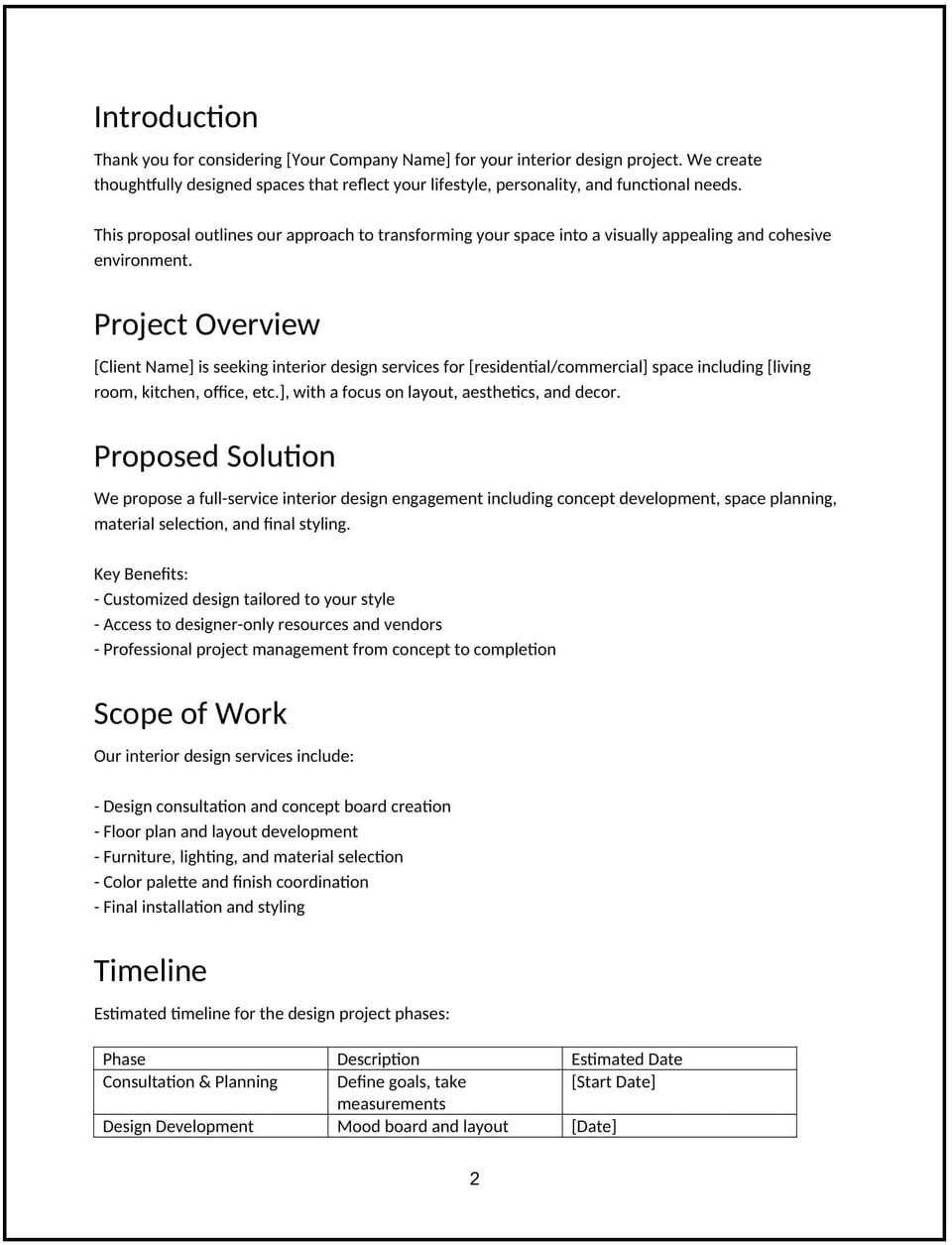Interior design proposal: Free template

Customize this free interior design proposal with Cobrief
Open this free interior design proposal in Cobrief and start editing it instantly using AI. You can adjust the tone, structure, and content based on the project type, client preferences, and scope of services. You can also use AI to review your draft — spot gaps, tighten language, and improve clarity before sending.
Once you're done, send, download, or save the proposal in one click — no formatting or setup required.
This template is fully customizable and built for real-world use — ideal for residential makeovers, commercial interiors, furniture planning, or full-space transformations. Whether you’re pitching a single-room redesign or a full home concept, this version gives you a structured head start and removes the guesswork.
What is an interior design proposal?
An interior design proposal outlines the creative vision, deliverables, pricing, and timeline for a design project. It’s typically sent by designers or design firms after a discovery call or site visit and serves as the first formal step toward project approval.
The proposal defines what spaces will be designed, what services are included (like mood boards, sourcing, styling), and how the process will unfold — from concept to installation.
An interior design proposal helps:
- Communicate your design vision and how it meets the client’s needs
- Set expectations around timeline, deliverables, and design phases
- Provide clear, professional pricing for services and sourcing
- Build trust through structure and attention to detail
If you're offering design services and want to turn interest into a project, this is the right format to use.
Why use Cobrief to edit your proposal
Instead of cobbling together a doc in Word or Canva, use Cobrief to create, refine, and send a clean, AI-powered proposal in minutes.
- Edit the proposal directly in your browser: Skip the design software — just click and start editing
- Rewrite sections with AI: Shorten, expand, simplify, or refine your language with smart suggestions
- Run a one-click AI review: Identify unclear descriptions or areas where you can clarify value
- Apply AI suggestions instantly: Approve edits one-by-one or apply all with one click
- Share or export instantly: Send a link or download a branded, polished PDF or DOCX file
Cobrief makes your proposal look as professional as your work — without the formatting stress.
When to use this proposal
This interior design proposal is ideal for:
- Pitching a full-room or multi-room residential design project
- Proposing design services for offices, retail spaces, or commercial interiors
- Quoting furniture plans, styling, or finish/material selections
- Formalizing a scope and price after a walkthrough or design consultation
- Following up on an inbound design inquiry with a structured plan
Use this when you want to go from creative vision to project approval.
What to include in an interior design proposal
Each section is structured to guide your client through your offer — clearly and confidently. Here’s how to use them:
- Executive summary: Outline the client’s design goals and how your proposal meets them (e.g., “Redesign the living and dining areas to create a modern, functional open-plan space with layered lighting and custom storage.”)
- Scope of work: Detail what’s included — floor plans, mood boards, color palettes, furniture sourcing, styling, procurement, installation, etc. Be specific.
- Design phases and timeline: Break down the project into stages — concept development, design finalization, sourcing, delivery, and install — with estimated durations.
- Materials and sourcing: Clarify if you’ll handle sourcing, ordering, and receiving. Mention any trade discounts, preferred suppliers, or client approval steps.
- Fees and pricing: List your fee structure — fixed fee, hourly, or by phase. Clarify if furnishings and materials are included or quoted separately.
- About you / your team: Share your experience, style, or process. Include notable past projects or design specializations.
- Terms and conditions: Cover payment terms, cancellation, revisions, and responsibilities (e.g., client approval, lead times). Keep it in plain English.
- Next steps: Tell the client exactly how to move forward — e.g., “Reply to confirm the proposal and book a kickoff meeting.”
How to write an effective interior design proposal
Design clients care about clarity, creativity, and process. Use these tips to build confidence and move the project forward:
- Match the client’s language: Mirror how they talked about their needs — function, mood, lifestyle
- Be structured but flexible: Show process while leaving room for collaboration
- Avoid generic promises: Talk specifically about what you’ll deliver and how it helps
- Make pricing transparent: Clearly separate design fees from material/furniture costs if applicable
- Show reliability: Include timelines and expectations for communication or approvals
- Always end with action: Make it easy for the client to say yes
Frequently asked questions (FAQs)
Can I use this for both residential and commercial clients?
Yes — just tailor the scope and design phases to fit the project type.
Can I include product sourcing in this proposal?
Absolutely — you can offer sourcing, purchasing, and trade discount coordination as part of the scope or as an add-on.
Can I break the project into phases?
Yes — phasing by room or by design stage can help clients plan around budget or timelines.
Can I export a visual version with my branding?
Yes — after editing in Cobrief, you can export a clean, formatted PDF or DOCX with your logo and fonts.
Is this a contract?
No — this is a proposal. You can attach or send a service agreement separately if needed.
This article contains general legal information and does not contain legal advice. Cobrief is not a law firm or a substitute for an attorney or law firm. The law is complex and changes often. For legal advice, please ask a lawyer.